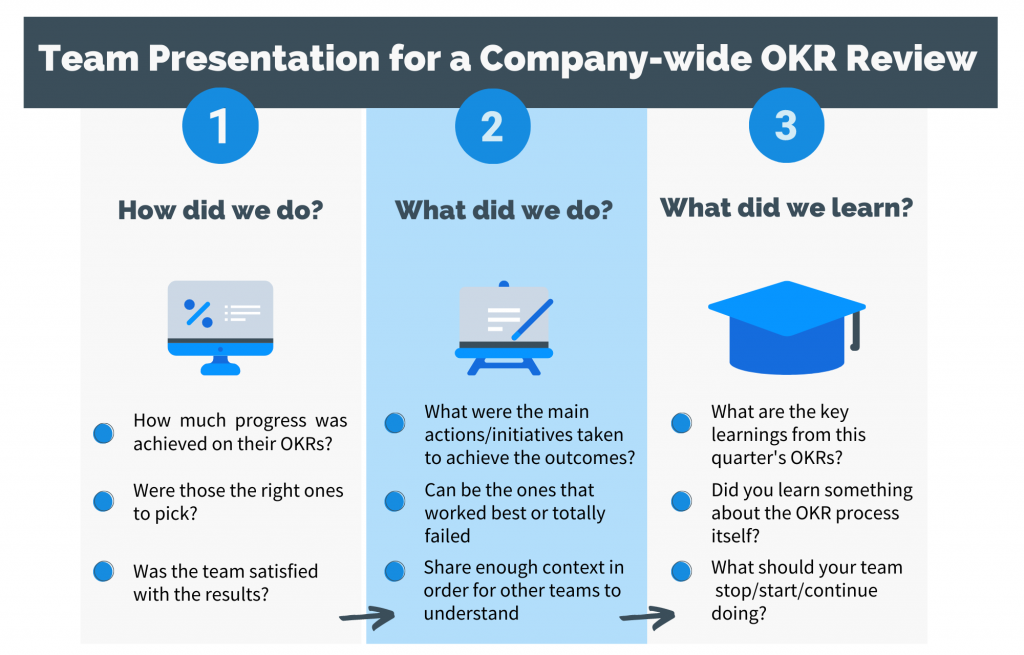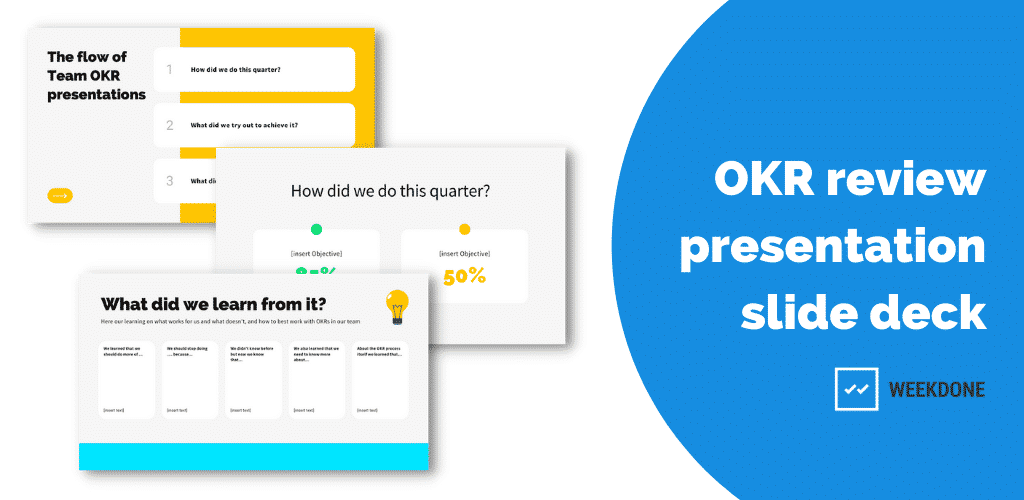The end-of-the-quarter review is a great opportunity to share your learnings with the rest of the company. It’s also a great time to air out any doubt or any new innovative ideas that you feel should be further discussed.
We have a great retrospective template for you to use in Google Slides or on a digital whiteboard tool.
In this article, we will cover the best practices for team-specific and company-wide retrospectives.
Organizing internal OKR reviews in a team
Like any other meeting, a retrospective review is only as valuable and productive as the preparation made by all of the participants.
We will share a list of good questions for OKR reviews to guide your preparation process better.
Questions to improve internal communication
- How did the team generally perform? What did we achieve?
- How was the quality of the OKRs set? Did they help the team to make some improvements?
- Did we prioritize the OKRs enough? Were people working on them?
- Were people aware of the roles and responsibilities they had? Did they feel that they knew what to do?
- How often did we discuss the progress? Was it consistent?
- How can we be better at setting OKRs next quarter? What do we have to keep in mind?
Questions to understand what helps us win
- Why were we successful in achieving the Objectives?
- Was it intentional or was there luck involved?
- What kind of actions brought the highest results?
- Are there things that we can improve even more?
- Can we use what helped us succeed in some other areas as well?
- What are the key takeaways from our success that we can share with others?
Questions to learn from failures and challenges
- If we failed then why? What did we try and why do we think it didn’t work?
- Most probably something failed for sure, if it wasn’t a Key Result, it was some kind of action that didn’t bring results. So, what doesn’t work for our Team/Company?
- What were the major challenges?
- Why did those major challenges appear? Can we prevent them in the future? How?
- What kind of knowledge or experience might we be missing? How can we gain it or did we already?
Questions to analyze what to do better in future
- What are the key things we learned and have to keep in mind while making decisions in the future?
- What kind of new opportunities have we noticed?
- What we as a Company or a Team should start doing? Or what should we continue doing?
- What should we stop doing?
The retrospective team meeting itself should have two outputs:
- a longer report of team learnings, ideas, etc.
- and a shorter summary (bullet points) to present to others in the company.
The longer report is for the internal use of the team as it’s a more detailed description of their learnings. The second summary is for a company-wide review as there’s a time limit involved during any presentation and probably there is no need to share all of the details.
Team presentation for a company-wide review
When preparing for a presentation, teams should keep in mind that all things presented should be understandable for other teams. That means if you are talking about some kind of action that helped to achieve great progress on your Key Result, then be ready to explain and offer more context in order for others to understand.
It may not be so easy for Production or Business Development to understand how Digital Marketing works and what different abbreviations mean, etc. If people do not understand the context, it’s hard to make sure that they will learn anything from your experience.
Think about the presentation as telling a story – before getting to the main point there’s an introduction to give enough background which makes understanding the main point possible.

Each team should be ready to talk about 3 main points during the Company-wide review:
- How did the Team do? How much progress did the Team achieve on their Objectives and Key Results? Were those the right ones to pick? Besides telling how much was achieved percent-wise, also explain if the team is satisfied with the results.
- What were the main actions/initiatives taken to achieve the outcomes? Introduce a couple of the most relevant ones. Those can be the ones that worked best or failed totally.
- What are the key learnings from this quarter’s OKRs? Share 3-6 main takeaways. Did you learn something about the OKR process itself? What should the Team stop/start/continue doing?

Check this OKR review presentation slide deck with 18 slides that you can use to prepare for the team & company OKR review
Organizing a company-wide OKR review
Once team retrospectives are done, it’s time to organize a company-wide event where each team can present what they have learned this quarter. After each presentation, leave time for other teams to ask questions and share their ideas/feedback.
Usually, people need time to think about their questions or they might feel that it’s not the right time for it.
So we recommend sharing your team’s bullet points before the event and inviting other teams to read through and add questions as comments or sticky notes.
This way you can focus your presentation on the main highlights and spend more time on open questions and things you would do differently.
After the presentations are done, discuss together how everyone felt about the company’s overarching Objectives. Was this focus right? Did teams notice Company-wide improvements taking place? Do they feel that they were really aligned?
At the end of the review session, it would be good for the leader or the facilitator to deliver a short summary speech. It should be about acknowledging the hard work done by the teams and repeating the most important lessons learned which caught their attention the most. If the management already has ideas for next Quarter’s Company Objectives then it would be a good time to share them as well.
Special tips for bigger companies
If your company has many teams and more layers in the company structure, a retrospective could take a very long time. In that case, organizing several review sessions would make more sense. Organize the sessions with the teams that would benefit from hearing each other’s learnings. The purpose of the cross-functional review would be to hear each team’s presentation, have a discussion, and make a summary that can be presented during the company-wide review. To deliver this cross-functional overview during the company-wide retrospective, consider following this structure:
- How much progress in general did the teams have with their OKRs? Were they satisfied with the impact they made?
- What were the main actions/initiatives taken to achieve the outcomes? Introduce the most impactful deliverables, the most time-consuming ones, and the ones that failed but helped teams learn.
- What are the key learnings from the OKRs? Share up to 10 main takeaways from different Teams.
OKR processes help you improve the company culture, although implementing this kind of change is never easy. We recommend learning from the companies that have succeeded in leading the OKR rollout but always factoring in your unique organizational workflows and needs.
